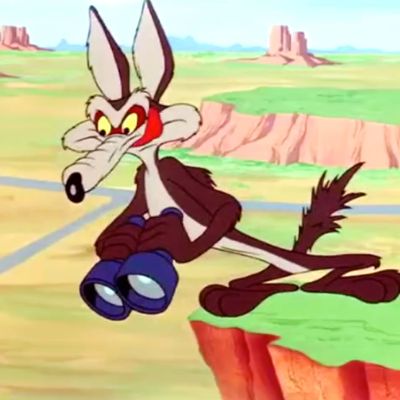
Seventy years ago, Wile E. Coyote and the Road Runner ran across a desert and into the American imagination. The pair debuted on September 17, 1949, in a Looney Tunes short prophetically titled ÔÇ£Fast and Furry-ous.ÔÇØ IÔÇÖm not saying Chuck Jones preemptively parodied the Fast and Furious movies 60 years before they came out, but I am saying the deranged physics of the southwestern world he created means you canÔÇÖt entirely rule it out. If thereÔÇÖs a law to Wile E. CoyoteÔÇÖs reality, itÔÇÖs that anything is possible, and the more impossible something is, the more likely it is to happen.
ÔÇ£Fast and Furry-ousÔÇØ opens like a nature documentary gone haywire, the action pausing to give predator and prey fake Latin binomials, as if at any moment you can expect to hear David Attenborough avuncularly exclaim, ÔÇ£But the coyoteÔÇÖs prey slips away just as the dynamite explodes in his hand.ÔÇØ From there it goes into, literally, overdrive. Earlier cartoon shorts with characters like Bugs Bunny often defied the laws of nature in favor of the absurd, but Coyote and Road Runner took cartoon physics to its breaking point.
IÔÇÖve been watching the shorts with my 5-year-old son, Liam, who hasnÔÇÖt taken to many of the beloved classics of my childhood, but adores Wile E. Coyote and Road Runner. He likes the 2014 CGI cartoons, too, with their younger, more childlike Coyote and Road Runner, but the originals send him into fits of laughter. Despite their age, they still feel fresh ÔÇö or rather, eternal. ItÔÇÖs almost hard to believe that the struggle between the Coyote and the Road Runner hasnÔÇÖt always played out in the background of the human imagination, alongside the tortoise and the hare. The setting certainly helps. Coyotes may live all over the U.S., but Wile E. never leaves his southwestern desert home, with those cathedral-like mesas and cacti pillars that John Ford and other directors turned into the backdrop of AmericaÔÇÖs own myth-making.
Wile E. Coyote has his own mythic quality, of course. Created by director Chuck Jones and writer Michael Maltese, and later voiced by Mel Blanc, he bears a passing resemblance to the Coyote figure common to Native American religions and folklore. That older Coyote is, like his cartoon descendant, anthropomorphic, sometimes good, sometimes evil, sometimes a trickster, sometimes a fool. Wile E.ÔÇÖs also scrawny, mangy, a ÔÇ£living, breathing allegory of Want,ÔÇØ as Mark Twain put it, summarizing the Anglo-American view of the coyote as little better than a pest. More than anything, Wile E. CoyoteÔÇÖs a mix of centuries of Native and settler depictions of canis latrans, put in a blender set to ÔÇ£ridiculous.ÔÇØ
HeÔÇÖs also a stock character, another in a long line of cat-and-mouse cartoon predators. But unlike his peers ÔÇö Tom the Cat, Sylvester, Elmer Fudd, Yosemite Sam, his copy-paste cousin Ralph Wolf ÔÇö Wile E. is the sole protagonist of the shorts. We donÔÇÖt necessarily root for him to catch the Road Runner, but we do sympathize with him. Partly thatÔÇÖs his build: HeÔÇÖs far more human than the Road Runner. He walks on two legs, orders gadgets by mail, talks sometimes, and has a middle initial. And unlike his peers, his nemesis the Road Runner doesnÔÇÖt have much of a personality. ItÔÇÖs less a battle of wits or equals than a lone (wolf) man trying to take down a force of nature. The Road Runner is GodÔÇÖs perfect fool, blessed with hypersonic speed and the inexhaustible goodwill of an otherwise sadistic and capricious reality. He can run through paintings, or invisible brick walls, or across vast stretches of open sky. His pursuer cannot. Wile E. CoyoteÔÇÖs schemes and traps sometimes fall apart due to his own hubris, but like any Greek tragic hero, heÔÇÖs doomed from the start. The universe has it out for him.
Still, he perseveres, and maybe thatÔÇÖs what makes Wile E. Coyote so endearing. America loves an underdog, even if he is a predator trying to devour an innocent bird. Dan Flores, in his wonderful book Coyote America, even calls Wile E. an ÔÇ£avatar [of postwar America] in a coyote suit.ÔÇØ In FloresÔÇÖs view, Wile E. starts off simply famished and then becomes too sure of his own genius and obsessed with mail-order technology and gimmicks. ItÔÇÖs sadly a more relevant metaphor than Flores intends. A plucky, ravenous predator high on his supposed intelligence whose technological schemes always blow up in his face is a pretty good description of the U.S. right now, too.
ThatÔÇÖs the real key to the success of Wile E. Coyote. Like any good mythic figure, including the Native American coyote, Wile E. can be whatever we need him to be: a wild animal, Want, a Western cowboy, a dad, America itself. But none of those definitions fully fit either. Wile E.ÔÇÖs too smart and fast for that. We get so close, but we never can quite get a hold on him. And more than anything, doesnÔÇÖt that make you want to dust yourself off and start the chase again?

